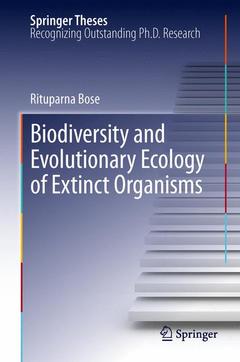Biodiversity and Evolutionary Ecology of Extinct Organisms, 2013 Springer Theses Series
Auteur : Bose Rituparna

Dr. Rituparna Bose (M.S., PhD) is currently an adjunct Assistant Professor in the Department of Earth and Atmospheric Sciences in the City College of New York.
Dr. Bose obtained her undergraduate education at the University of Calcutta, India and authored a thesis paper in environmental geology (coastal management). She came to United States in 2004 to pursue higher studies. During the course of her graduate studies at Bowling Green State University and Indiana University at Bloomington, she was the primary author in multiple high-impact peer-reviewed publications. Here she was awarded the Indiana University Dissertation Year Research Fellowship which is given to the best doctoral students of the university. Her work with Dr. Margaret Yacobucci and Dr. David Polly culminated in major findings in evaluating the evolution and determining the biodiversity of extinct organisms. As a result of her findings which have profound implications in bio-conservation, she won major national awards like the Theodore Roosevelt Memorial Grant (American Museum of Natural History) and Schuchert and Dunbar Grant (Yale Peabody Museum of Natural History). Additionally, BP Global Energy Group funded her to present these findings at North American Paleontology Convention (NAPC) by the prestigious NAPC Travel Award.
Dr. Bose continues to pursue both her teaching and research career. Her research interests lie in applications of quantitative algorithms to study evolutionary biology, micropaleontology, disaster management studies and other applied geological sciences. In addition, she teaches courses in Physical Geology, Earth System Science, Environmental Geology, Natural Disasters and Historical Geology.
Date de parution : 09-2014
Ouvrage de 102 p.
15.5x23.5 cm
Date de parution : 08-2012
Ouvrage de 102 p.
15.5x23.5 cm



